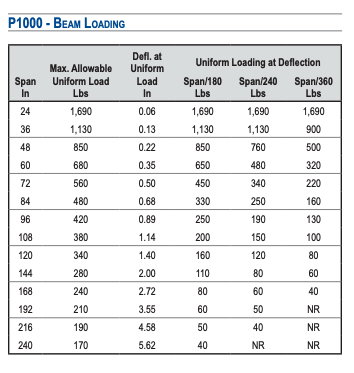How to Calculate the Beam Load for Your Ceiling Grid
April 4, 2024
When deciding which Unistrut channel is the right choice for your ceiling grid, there are plenty of questions to ask, and many of them have straightforward answers. What type of structure will the grid be hanging from? Do you have a finish preference? What will the grid be supporting? One crucial question that takes some calculations to answer is, can a specific Unistrut channel support the load of my systems?
The answer to that lies in the Unistrut beam loading table for the channel profile in question. Unistrut provides beam loading tables for all channel profiles, but reading them and determining an accurate total uniform load can be complicated, and disastrous if calculated incorrectly. Below, we’ll go over the steps needed to accurately calculate the beam load of the channel for your ceiling grid via beam loading table.
Tips for Reading Unistrut Beam Loading Tables

Unistrut provides beam loading tables for all channel profiles in the General Engineering Catalog. Be sure you’re referring to the correct table when making your calculations.
When calculating your beam load, remember that the provided tables help calculate the total uniform load (W Lbs), not uniform load (w lbs/ft or w lbs/in). To find the uniform load (w lbs/ft or w lbs/in), divide the load by the span.
The table also includes columns with values for uniform loading at deflection for structures that require limited deflection or sag. These columns utilize standard engineering practice ratios of span/180, span/240, and span/360. If your build requires designing to one of these deflection limits, use the appropriate value in place of the maximum allowable uniform load measurement.
How to Calculate Unistrut Beam Load
The information you need to determine the total uniform load of your Unistrut channel is:
- The type of Unistrut channel being used
- The desired span of the channel in inches
- If the channel is pierced and if so, which series
- If the channel will be adequately laterally braced and if it is unbraced, the span of the unbraced sections in either feet or inches
- The weight of your applicable Unistrut channel
- If your design calls for a concentrated midspan point load
With that information in mind and using the appropriate beam loading table for your channel, here are the steps to determining the total uniform load for your Unistrut channel.
- Determine the maximum allowable uniform load from the load table based on your desired span in inches and if you are designing to deflection limit
- If your channel is pierced, multiply the maximum allowable uniform load found in step one by the following factor:
- “KO” Series: 95%
- “T” Series:85%
- “HS” Series: 90%
- “SL” Series: 85%
- “H3” Series: 90%
- “DS” Series: 70%
- “WT” Series: 85%
- If your channel is unbraced, use the table on page 62 of the General Engineering Catalog to multiply your maximum allowable uniform load by the applicable unbraced length factor
- Subtract the channel weight from your calculated maximum allowable uniform load (for example, P1000 has a weight of 189 lbs per 100 feet)
- This result is the net allowed total uniform load in pounds
- If you have a concentrated midspan point load, multiply the beam load by 50%
- This result is the allowed midspan point load
With that result, you can determine if the channel option you are considering can support the load of your system when used in your ceiling grid.
Client Example
One of our clients was looking for a way to hang a drywall ceiling above a unique manufacturing space where the building structure joists were almost 48 feet above the finish floor and the manufacturing space ceiling had varying heights of 10 feet, 15 feet, 19 feet, and 21 feet above the finish floor. Additionally, the manufacturing space had spans between walls that were greater than 35 feet in some areas.
To accomplish this, the client needed a robust interstitial support system that would allow them to span those 35-foot+ spaces, attach drywall, and support necessary mechanicals below the drywall ceiling. Our team proposed adding Unistrut channel at the bar joist height spanning perpendicular to the bar joists, then dropping threaded rod from that Unistrut channel to support a 4 x 5-foot Unistrut ceiling grid.
To figure out the proper channel for the job, the Unistrut Midwest team calculated the following:
- Customer’s desired grid: 4 x 5 feet = 20 square feet
- 20 square feet x customer’s desired load capacity (35 lbs per foot) = 700 lbs supported for every 20 square feet
Using the P5001 Beam Loading Chart 120” span, the team calculated:
- 3210 maximum allowable uniform load x .54 from the lateral bracing load reduction chart = 1733.40
- Subtract the weight of the channel (10 feet x 6.1 lbs = 61 lbs)
- 1733.40 - 61 = 1672.40 lbs
- Multiply by 50% for worst-case midspan loading (using the table on page 18 of the General Engineering Catalog)
- 1672.40 x .50 = 836.2 lbs
Thus, each 10-foot span of P5001 can support up to 836.20 lbs as a single point load from the midspan of the channel, exceeding the client’s required 700 lbs of support per 20 square feet.
Without leveraging a Unistrut ceiling grid, the drywall contractors would have had to hang supports from the bar joists 48 feet above the finish floor to support their ceiling, and the mechanical and electrical contractors would have had to attach all of their supports to those 48-foot high bar joists as well. In that scenario, once the drywall ceiling is installed, how do you drop threaded rod and supports down from the bar joists above the drywall ceiling?
By installing the Unistrut ceiling grid just above the drywall, the mechanical and electrical contractors were able to easily attach their threaded rod stubs to the Unistrut channel prior to the drywall ceiling installation. The drywallers could then attach their furring strips to the Unistrut grid and lift the drywall into place, having holes in the drywall in the mechanical and electrical threaded rod drop locations. The cable trays and pipes could then hang about 9 feet above the finished floor height.
Turn to Unistrut Midwest
While calculating the beam load is a crucial part of the ceiling grid design and engineering process, there are more considerations needed in order to determine the load rating of your overall ceiling grid system. Fitting selection is an especially important step, as the fittings used in your build will also determine the load rating of the ceiling grid system.
Calculating the beam load (as well as overall ceiling grid load, including fittings) is part of our ceiling grid design and engineering process. With years of experience in designing ceiling grids for clients with different load requirements, our team is happy to review your initial findings or take over calculations completely, ensuring you the perfect Unistrut channel for your ceiling grid solution. To get started, gather the necessary information and then contact our team.


